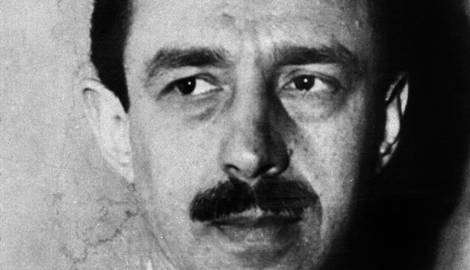
When it comes to notorious unsolved murders, the death of Elizabeth Short, better known as the Black Dahlia, is one that generally tops the list. Prominent for its gruesome details and the death of a beautiful, hopeful young woman, the murder is forever emblazoned on the consciousness of America. While many suspects have been suggested, one name that keeps returning to the discussion is that of Dr. George Hodel. In fact, his own family has even suggested his involvement. Do the accusations against Hodel stand up?
Twisted Genius

A son of Russian-Jewish parents, George Hodel was raised in California and was born in 1907. He was incredibly intelligent, musically talented, and academically gifted, scoring 186 on an early IQ test. However, he also showed indications of favoring the debauched.
At age fifteen, he began studies at the California Institute of Technology (CalTech). During his tenure, he started a sexual affair with the wife of one of his professors, and as a result, she became pregnant. When the dalliance was revealed, Hodel was expelled from CalTech and moved his focus to interests other than his education for a while.
Becoming Doctor Hodel

During the 1920s and 30s, Hodel took up photography and started a magazine. His first two marriages (there were five in total) occurred during these years, and he had children from both unions.
Eventually, Hodel returned to school, graduating from the University of California-Berkeley with a pre-med degree in 1932. He continued his medical studies and graduated with a medical degree in 1936. Within a few years, he had a thriving medical practice and was soon appointed to lead the county’s Social Hygiene Bureau. In this role, his specialty was venereal disease, but he also performed secret abortions. Many desperate women sought out his expertise, and it was said that Hodel held furtive secrets regarding many locals as a result.

Hodel’s closest companion during this time, besides his respective wives, was his secretary, Ruth Spaulding. In working by his side, she was also privy to a great deal of confidential information about patients and about Hodel himself.
It was rumored that he had engaged in financial fraud in regard to his business. There was also the matter of the illegal abortions that were allegedly performed at the clinic. Spaulding would have been aware of all of these skeletons in Hodel’s closet.

In 1945, Spaulding died suddenly. According to the medical examiner, she passed away from a drug overdose, and the matter was ruled a suicide. However, at the time and in the years since, there has been much speculation that Hodel was responsible for Spaulding’s death. He was there when she died and was found to have burned several documents before calling the police to report her death.
Within a few days, he had left for China, volunteering to work with the United Nations for a stint. Since Spaulding’s death was ruled a suicide, there was never an investigation, and Hodel was never officially viewed as a suspect, despite the suspicion of many.
House of Horrors

In 1945, Hodel purchased the Sowden House, a Mayan-style structure designed by Lloyd Wright (son of Frank Lloyd Wright). His most recent ex-wife moved to the property as well, along with their children. The unique home soon became a house of horrors under Hodel’s ownership. He physically abused his children in the house’s dark basement and threw twisted, sybaritic parties that were known for involving copious amounts of drugs along with sexual orgies.

In fact, Hodel’s daughter, Tamar, ran away in 1949 and was soon taken into police custody. She claimed she ran away after her father and others raped her during a party at the home. Later, she would accuse her father of sexual abuse from the time she was a preteen and of allowing his friends to photograph her nude.
Despite eyewitnesses testifying on her behalf, Tamar was branded a liar, and Hodel was acquitted of incest charges at the end of 1949. In fact, her own mother called her a liar. Tamar was sent to a juvenile detention center after the case.
Tamar maintained that she wasn’t the only woman who suffered at the hands of her father, a claim that would be verified by others who lived in and visited the home. Women were constantly in and out of the home, some willingly, but perhaps, according to witnesses, some not.
The Black Dahlia

Was one of these women the Black Dahlia, Elizabeth Short? In January 1947, a gruesome sight was discovered by a mother taking a stroll with her child: the bisected body of a young woman. The body was lying just off the sidewalk, completely naked and covered with extensive mutilation. However, the lack of blood at the scene suggested that the murder and maiming had taken place elsewhere.
The Los Angeles police department, in conjunction with the FBI, began an investigation and soon identified the body as Elizabeth Short, a 22-year-old who, like so many others, had moved to California with dreams of becoming a successful actress.

The victim soon became known as the “Black Dahlia,” a spin-off of a popular movie at the time, The Blue Dahlia, in conjunction with her dyed black hair and clothing. The media went wild with the new moniker and the case itself, and it wasn’t hard to see why. Short’s beauty, hopeful dreams, and the violent way in which she died were perfect tabloid fodder.
A Frustrating Mystery

The case was challenging to work from the beginning. Close to fifty people went to the LAPD claiming to be the murderer, hoping for a shot at fame. Tip lines at the station rang day and night. Reporters were even said to withhold evidence in hopes of scoring a big scoop.
Several notorious suspects were named in the case, including Dr. George Hodel. Hodel was questioned, and his home was even wiretapped. On one police tape, Hodel is recorded as saying, “Supposin’ I did kill the Black Dahlia. They couldn’t prove it now. They can’t talk to my secretary [Spaulding] anymore because she’s dead.”
In 1950, a Los Angeles newspaper reported that police were planning to arrest a Black Dahlia suspect, quoting an anonymous source. Imminently, perhaps in response, perhaps coincidentally, Hodel left California, leaving his ex-wives and children behind. He stayed in Hawaii for two years, then moved to the Philippines with a new wife, Hortensia Laguda.

Hodel would spend many more years abroad, save random and brief visits with his sons in Los Angeles. He also made stopovers in Chicago and San Francisco, where he has been posthumously accused of murders during those time frames. In 1990, when he was 83 years old, Hodel permanently returned to the United States with his fifth wife, June Hirano, whom he’d married the year before. He passed away in 1999.
A Son’s Crusade

Hodel’s son, Steve Hodel, a former police officer, was tasked with going through some of his father’s things after his death. While looking through an album of photos, he came across some disturbing images among family photos: shots of numerous nude women, including one with black hair that he thought looked familiar but couldn’t place.
Later, when speaking with his half-sister, Tamar, she told him, “You know, Dad was a suspect in the Black Dahlia case,” and the image of the black-haired woman instantly came back to Steve’s mind.
He was disturbed to think that his father may have known Elizabeth Short but believed there was no way he was a murderer. Steve remembered his father as often absent but a “great man.” Other family members call Steve Hodel the “favorite son,” with a stronger attachment to his dad than the other children. He didn’t know many of the details of his father’s sordid side. His first instinct was to prove his father’s innocence.

However, Steve soon came to feel that his first impulses were very wrong. After viewing letters that were sent to the police and press by the Black Dahlia’s killer, he was struck by how similar the block printing was to his own father’s. Steve Hodel decided to spend his retirement pursuing the truth behind his father’s involvement in the Black Dahlia case and other potential crimes.

Steve’s investigation took him throughout Los Angeles, interviewing retired law enforcement agents involved in the case, consulting forensic experts, poring over newspapers, and eventually using the information he gathered to write a book, followed by subsequent titles about his father’s criminality.

The younger Hodel has received some validation for his efforts, with an independent handwriting expert confirming that it is “highly probable” that Dr. Hodel wrote the letters to the police and press. In addition, in 2002, Deputy District Attorney Steven Kay reviewed Steve Hodel’s work and the case as a whole, stating that if George Hodel were alive, he would have no problem filing murder charges against him, confident that he would be convicted.

Steve Hodel has continued to research his father’s potential crimes, proposing that he may be tied to the unsolved Zodiac killings in California in the 1960s and others. His family has been generally supportive of his work and agrees with his findings. However, with Hodel’s death, a chance to bring Elizabeth Short’s killer to justice may have also died. Though evidence mounts, the Black Dahlia case will likely remain unsolved. George Hodel was many things: brilliant, abusive, and sick, but whether or not he was a killer remains an unconcluded chapter in his story.










